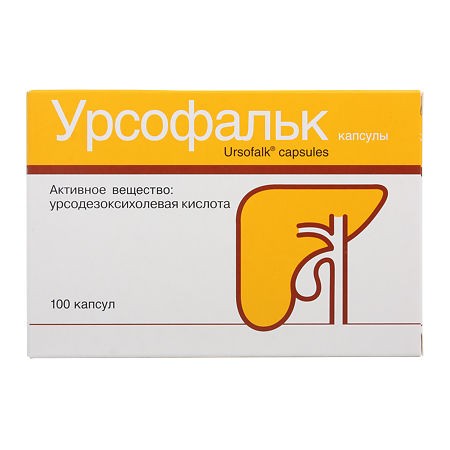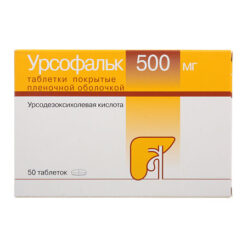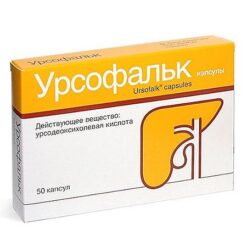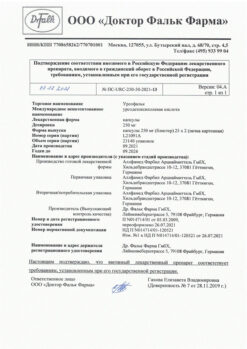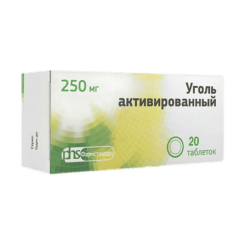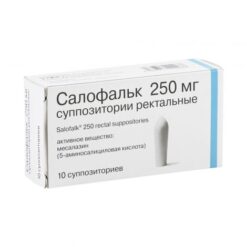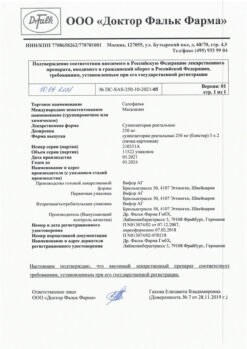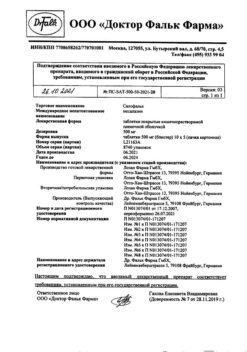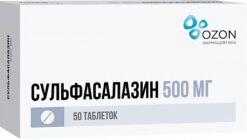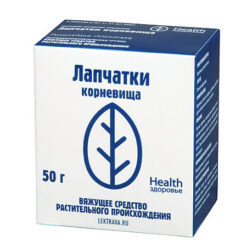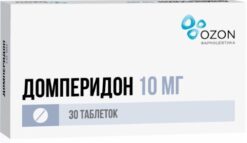No products in the cart.
Ursofalk, 250 mg capsules 100 pcs
€45.98 €41.88
Description
Pharmacodynamics
With high polar properties UDCA forms non-toxic mixed micelles with apolar (toxic) bile acids, which reduces the ability of refluxate to damage cell membranes in biliary reflux gastritis and reflux esophagitis. In addition, UDCA forms double molecules capable of incorporating into cell membranes, stabilizing them and making them immune to the action of cytotoxic micelles.
Limits the saturation of bile with cholesterol by inhibiting its absorption in the intestine, suppressing its synthesis in the liver and reducing its secretion into the bile; increases the solubility of cholesterol in bile, forming liquid crystals with it; reduces the lithogenic index of bile. The result is the dissolution of cholesterol gallstones and prevention of formation of new concrements.
The immunomodulatory activity is caused by inhibition of expression of HLA-antigens on membranes of hepatocytes and cholangiocytes, normalization of natural killer activity of lymphocytes, etc. Significantly delays the progression of fibrosis in patients with primary biliary cirrhosis, cystic fibrosis and alcoholic steatohepatitis, reduces the risk of developing esophageal varices.
For the successful dissolution of gallstones, it is necessary that the stones are pure cholesterol stones, their size does not exceed 15-20 mm, and the gallbladder (filled with stones no more than half) and the biliary tract fully retain their function.
Pharmacokinetics
Absorbed in the jejunum by passive diffusion, in the ileum by active transport. When administered orally in a single dose of 500 mg, serum concentrations after 30, 60 and 90 minutes are 3.8, 5.5 and 3.7 µmol/L, respectively. With systemic administration ursodeoxycholic acid (UDCA) becomes the main bile acid of blood serum (48% of total bile acids).
It is included in the enterohepatic circulation system. The therapeutic effectiveness of the drug depends on the concentration of UDCA in bile. On the background of the therapy there is dose-dependent increase of UDCA share in the bile acid pool up to 50-75% (at daily doses of 10-20 mg/kg). It penetrates through the placental barrier.
Indications
Indications
Dissolution of cholesterol gallstones;
biliary reflux gastritis;
primary biliary cirrhosis of the liver in the absence of signs of decompensation (symptomatic treatment).
Pharmacological effect
Pharmacological effect
Pharmacodynamics
Having high polar properties, UDCA forms non-toxic mixed micelles with apolar (toxic) bile acids, which reduces the ability of refluxate to damage cell membranes in biliary reflux gastritis and reflux esophagitis. In addition, UDCA forms double molecules that can be incorporated into cell membranes, stabilize them and make them immune to the action of cytotoxic micelles.
Reduces the saturation of bile with cholesterol by inhibiting its absorption in the intestine, suppressing synthesis in the liver and reducing secretion into bile; increases the solubility of cholesterol in bile, forming liquid crystals with it; reduces the lithogenic index of bile. The result is the dissolution of cholesterol gallstones and the prevention of the formation of new stones.
The immunomodulatory effect is due to inhibition of the expression of HLA antigens on the membranes of hepatocytes and cholangiocytes, normalization of the natural killer activity of lymphocytes, etc. Significantly delays the progression of fibrosis in patients with primary biliary cirrhosis, cystic fibrosis and alcoholic steatohepatitis, reduces the risk of developing esophageal varices.
For successful dissolution of gallstones, it is necessary that the stones are purely cholesterol, their size does not exceed 15-20 mm, and the gallbladder (no more than half filled with stones) and bile ducts fully retain their function.
Pharmacokinetics
Absorbed in the jejunum due to passive diffusion, in the ileum – due to active transport. When taken orally in a single dose of 500 mg, the concentration in the blood serum after 30, 60 and 90 minutes is 3.8, 5.5 and 3.7 µmol/l, respectively. When taken systematically, ursodeoxycholic acid (UDCA) becomes the main bile acid in the blood serum (48% of the total bile acid content).
Included in the enterohepatic circulation system. The therapeutic effectiveness of the drug depends on the concentration of UDCA in bile. During therapy, there is a dose-dependent increase in the proportion of UDCA in the bile acid pool to 50-75% (at daily doses of 10-20 mg/kg). Penetrates through the placental barrier.
Active ingredient
Active ingredient
Ursodeoxycholic acid
Composition
Composition
Active ingredient:
ursodeoxycholic acid 250 mg.
Excipients:
magnesium stearate,
corn starch,
colloidal anhydrous silicon dioxide,
gelatin,
completed,
sodium sulfate,
titanium dioxide,
purified water.
Contraindications
Contraindications
Acute inflammatory diseases of the gallbladder and bile ducts.
Blockage of the common bile duct or cystic duct.
Side Effects
Side Effects
Diarrhea, nausea, pain in the epigastric region and right hypochondrium; calcification of gallstones; increased activity of liver transaminases (AST, ALT).
Allergic reactions.
When treating primary biliary cirrhosis, transient decompensation of liver cirrhosis may occur, which disappears after discontinuation of the drug.
Interaction
Interaction
Cholestyramine, colestipol and antacids containing aluminum hydroxide bind ursodeoxycholic acid in the intestine, interfere with its absorption and reduce its effectiveness (simultaneous use is not advisable).
Overdose
Overdose
Data on overdose are not provided.
Storage conditions
Storage conditions
At a temperature not exceeding 25 °C
Shelf life
Shelf life
5 years
Manufacturer
Manufacturer
Losan Pharma GmbH, Germany
Additional information
| Shelf life | 5 years |
|---|---|
| Conditions of storage | At a temperature not exceeding 25 °C |
| Manufacturer | Dr. Falk, Germany |
| Medication form | capsules |
| Brand | Dr. Falk |
Other forms…
Related products
Buy Ursofalk, 250 mg capsules 100 pcs with delivery to USA, UK, Europe and over 120 other countries.

